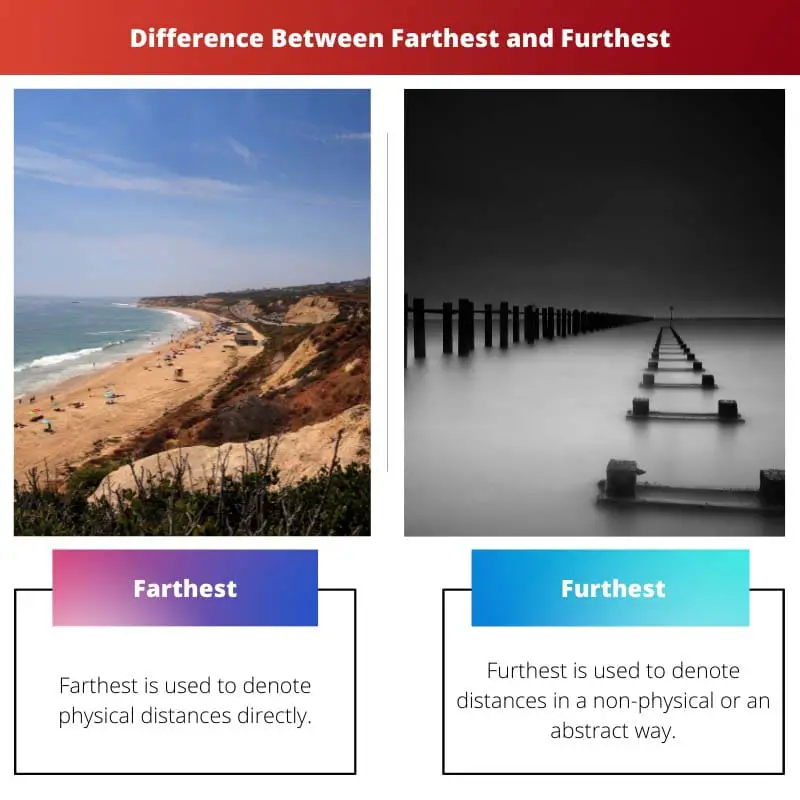‘Farthest’ and ‘Furthest’ are superlative adjectives or adverbs. Both these words are excellent irregular forms of the word ‘Far’.
Both the words ‘Farthest’ and ‘Furthest’ is used in denoting the distance. Incidentally, there is not much difference in their meaning.
The context in which these two words are used makes a lot of difference. Moreover, the usage of these words changes the context itself.
Key Takeaways
- Farthest is an adjective or adverb to describe the greatest physical distance or separation between two or more points or objects.
- Furthest is also an adjective or adverb that can describe the greatest physical distance. Still, it can also describe metaphorical or abstract distances, such as progress or extent.
- Although these terms are sometimes used interchangeably, using “farthest” for physical distances and “furthest” for abstract or metaphorical distances can provide clarity and precision in language.
Farthest vs Furthest
Farthest means “more distance” and can be used as both an adjective and an adverb. It is used for physical distances directly and is more commonly used when referring to distances. Furthest also describes distance but of a greater degree. It is used for figurative or abstract distances.

‘Farthest’ mostly denotes a physical distance, though not actual. But ‘Furthest’ indicates a physical space, though not actual, but longer than the distance conceptually.
At times, the word ‘Furthest’ can also mean an interior or remote place. Also, there are instances where the word ‘Farthest’ denotes the longest distance; conceptually, It denotes the distance in a specific direction.
There are a lot many differences that these both have from each other. Understanding and using them in the right areas shall make a big difference in speaking and writing.
Comparison Table
| Parameter of Comparison | Farthest | Furthest |
|---|---|---|
| Definition/Meaning | Farthest is used to denote physical distances directly. | Furthest is used to denote distances in a non-physical or abstract way. |
| Contextual Usage | Farthest is used in comparison with something or someone. | Furthest does not compare with any. |
| Conceptual Usage | Farthest describes distance as a physical quantity. | Furthest denotes distances as a higher degree. |
| As a Verb | Farthest is never used as a Verb | Furthest can be used as a Verb |
| Phrasal Usage | Farthest never features in any phrases | Furthest features in phrases too |
When to Use Farthest?
‘Farthest’ is a superlative adjective or adverb of the word ‘Far’. It is utilized in English to denote distance that is longer than expected.
‘Farthest’ is used in many contexts. Let us see them one by one.
- ‘Farthest’ indicates the physical distance that is so remote or more distant than any.
For E.g.
- Among all the students, John lives the farthest
- What is the farthest distance you have run in your life?
Above two sentences denote the physical distance. More importantly, they are in comparison with something.
Sentence (i) talks about John, who lives the farthest compared to the students in his class. Sentence (ii) talks about the distance a person runs compared to the other spaces covered.
- ‘Farthest’ can also indicate the time factor indirectly.
For E.g.
- John has been travelling the farthest so far.
- Lilly came from travelling the farthest distances.
Both sentences indicate distance, No doubt. But, it indirectly specifies the time factor.
Again, take a look at this sentence
‘John has not travelled the farthest’
This sentence has two underlying meanings
- John has not travelled far
- John should not take so much time as he has not travelled so far
The word ‘Farthest’ thus indicates the physical attributes of a context.

When to Use Furthest?
‘Furthest’ is again an excellent form of the word ‘Far’. It is also utilized to denote longer distances, but it is non-physical most of the time.
‘Furthest’ is a word that also helps to describe the time taken to complete a specific task. There are also many ways the word ‘furthest’ can be used.
- Remote and very long distances can be denoted using ‘Furthest’.
For E.g.
- The expedition team went to the furthest ends of Mars.
- The thieves ran away to the furthest corners of the jungle.
- ‘Furthest’ can also help denote the spatial distance from a specified point.
For E.g.
- Go to the furthest left corner of the refrigerator.
- The knife lies near the kitchen, which is at the furthest end.
These two sentences denote a point that is specific in spatial contexts.
- The word ‘Furthest’ helps indicate a particular point at the current moment.
For E.g.
- We must travel the furthest distance.
- The objective is to cover the furthest distance.
- ‘Furthest’ is used in English to denote a higher degree of something.
For E.g.
- You may have to stretch your legs to the furthest
- This project may take the most distant time of all.
In these two sentences, the word ‘ furthest’ denotes the higher degree of a particular action or situation.
Main Differences Between Farthest and Furthest
- The words Farthest and farthest tend to denote the distance factor. However, the main difference between Farthest and farthest is the former denotes the physical distance as such, while the furthest denotes the higher degree of the space measured.
- ‘Farthest’ always features itself as a comparison factor with something, while furthest stands independent and does not compare with any.
- Farthest denotes the physical distance covered, while the furthest attempts to indicate a non-physical or abstract distance.
- Farthest cannot be used as a verb, while Furthest can be used.
- Farthest never features in any phrases in the English language, while Furthest is used in phrases too.


This article has definitely shed light on the intricate differences between ‘farthest’ and ‘furthest’. Language is indeed fascinating in its nuances.
The complexity of language never fails to captivate. Delving into such lexical subtleties is indeed enriching.
I disagree, ‘farthest’ and ‘furthest’ can be used interchangeably without causing confusion. Language is always evolving and these distinctions may fade over time.
I respectfully disagree. While language does evolve, maintaining precision in language is important for clarity of communication.
The discussions on ‘farthest’ and ‘furthest’ are thought-provoking. It’s fascinating to delve into the subtleties of vocabulary usage.
Indeed, the analysis of these terms ignites a deeper appreciation for the complexity of language.
I never realized the depth of nuance in the use of ‘farthest’ and ‘furthest’. This article has been truly enlightening.
The comprehensive review on ‘farthest’ and ‘furthest’ is commendable. Understanding these distinctions is crucial for effective communication.
I completely agree. This article provides valuable insights into the intricacies of language usage.
The phrasal and conceptual differences highlighted in this article really showcase the intricacies of language.
Absolutely, understanding these nuances can greatly enhance our linguistic skills.
The explanations provided here have undoubtedly enriched my understanding of these superlative adjectives and adverbs.
This linguistics lesson is enlightening. The subtle discrepancies in meaning enrich the English language.
The distinction between ‘farthest’ and ‘furthest’ is quite useful. I’ll pay attention to the appropriate context to use each word.
Absolutely, being mindful of this distinction can indeed enhance written and spoken language.
The subtle differences make me appreciate the complexity and precision of the English language.
I appreciate the detailed comparisons. It’s intriguing to discern the varied contextual applications of ‘farthest’ and ‘furthest’.
The in-depth exploration of such nuances is truly valuable for language enthusiasts.
Absolutely, understanding these subtleties enhances linguistic precision and comprehension.
Thanks for the clarification. I will use ‘farthest’ when referring to physical distances and ‘furthest’ for abstract distances from now on.
That’s correct. It’s a subtle difference that can make our language more precise.